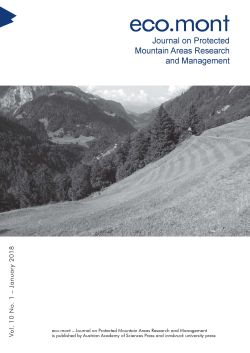
Eco.mont Vol. 10 Nr. 1, pp. 46-60, 2018/01/09
Journal on Protected Mountain Areas Research and Management

This study aimed to evaluate the effects of elevation, land use and canopy openness on species richness and composition of lichens in Ghunsa valley of Kanchenjunga Conservation Area, Eastern Nepal. At five elevational levels, from 2 200 m to 3 800 m, transects were established in four land-use types – cultivated land, meadows, exploited and natural forests. Detrended Correspondence Analysis (DCA) and Canonical Correspondence Analysis techniques were used to explore the lichen species distribution patterns. Generalized linear models were applied to analyse the impact of elevation and canopy openness on lichen species richness. Canopy openness was measured by hemispherical photography. A total of 229 species belonging to 71 genera were recorded. The length of the first DCA axis of 8.01 SD units indicated a complete species turnover and high beta diversity along the elevation gradient. Exploited forests with lower canopy openness supported higher lichen diversity than open meadows and cultivated areas. Significant differences in lichen species richness were found for different land-use types, along the elevation gradient, and with varying canopy openness. A gradual increase of lichen species richness from cultivated land to forests was observed. We concluded that substrate types that depend on land-use types as well as canopy openness significantly affect the distribution of lichen communities.
Keywords: canopy openness, Canonical Correspondence Analysis, Ghunsa valley, hemispherical photography, land-use change, lichen diversity